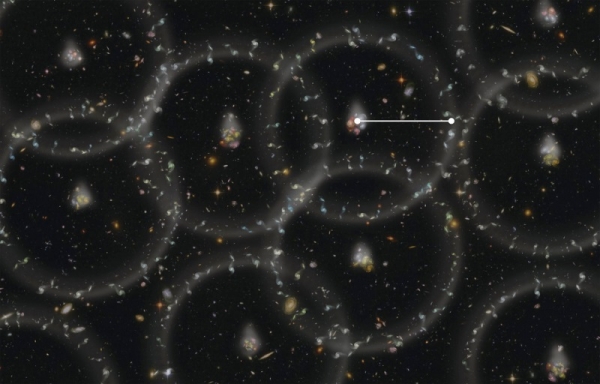After a complex statistical analysis of some one million galaxies, a team of researchers at several Chinese universities, and the University of Cordoba was able to publish the results of the study in the journal Nature Astronomy . They had been working on the project for over two years, which will make possible the determination of cosmological distances with a new and greater degree of precision.
The study developed a new method to detect what are called Baryon Acoustic Oscillations (BAO). These waves, whose existence was first demonstrated in 2005, are one of the few traces of the Big Bang that can still be detected in the cosmos. They spread during the first 380,000 years of the universe's life, expanding like sound waves through matter so hot that it behaved like a fluid, something similar to what happens when a stone is thrown into a pond. Subsequently, the universe expanded and cooled to the point that those waves were frozen in time.
The interesting thing about these oscillations, witnesses to almost the entire history of the cosmos, is that their exact duration is known (500 million light years), so they are currently very useful for measuring cosmological distances based on the separation between galaxies. Being able to detect them and determine their size is, therefore, of the utmost importance to correctly map the universe out to very distant points.
"The results of this study now allow us to detect these waves through a new and independent method. By combining the two, we can determine cosmic distances with greater precision," explained Antonio J. Cuesta, a researcher at the University of Cordoba's Department of Physics and the sole Spanish author on the study.
The new method: looking for anomalies in the orientation of galaxies
This new study analyzed, using statistical methods, a database of approximately one million galaxies, paying special attention to two very different factors: the ellipticity of the galaxies and the density around them.
In terms of their orientations, galaxies normally stretch to where there are a greater number of other galaxies, due to the pull of gravity, but there are certain places in the universe where this effect is not as intense. "It is in those points, where galaxies do not point where they should, where statistics tell us that the Baryon Acoustic Oscillations are located, since these waves also act as points of gravity attraction," explained Antonio J. Cuesta.
Looking out far, looking into the past
"The first practical application that this study could have is to establish more precisely where the galaxies are located, and the separation between them and the Earth, but, in a way, we are also gazing into the past," the researcher explained.
This new approach to Baryon Acoustic Oscillations, key to answering some of the great questions about the universe, opens new doors in the world of Astronomy. Establishing cosmological distances offers, in turn, new clues about the history of the universe's expansion and helps us to understand its composition in terms of dark matter and energy, two of the most elusive and enigmatic components of the cosmos.
Reference:
Xu, K., Jing, Y.P., Zhao, GB. et al. Evidence for baryon acoustic oscillations from galaxy–ellipticity correlations. Nat Astron (2023). 2397-3366. 2023/07/27. https://doi.org/10.1038/s41550-023-02035-4


